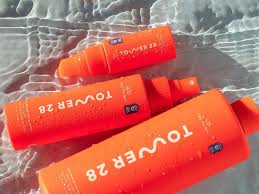Hypochlorous Acid Spray Is the New Trendy Acne Treatment
If you’ve been searching for the latest acne treatment, you’ve probably heard of hypochlorous acid spray. This trendy new ingredient isn’t actually that new—it’s been showing up in skincare products for years—but it’s been gaining a lot of attention on #SkinTok lately.
We understand that you might be hesitant to add a new product to your routine, especially if acne is one of your main skin care concerns. Every routine is about finding a delicate balance that works for you. That’s why we asked dermatologists Azadeh Shirazi, MD, and Marisa Garshick, MD, to break down what hypochlorous acid is, what it does, and if it works. Read on to find out if it’s right for you.
What is Hypochlorous Acid?
“Hypochlorous acid is a substance that our bodies produce naturally in our white blood cells,” Shirazi explains. It’s an acid that our bodies produce that “has antibacterial and anti-inflammatory properties,” Garshick adds. It’s very popular in the skincare industry because of its antibacterial properties.
Hypochlorous Acid Benefits
Hypochlorous acid has a ton of benefits, treating everything from acne to wound healing. Here’s an overview of the benefits you can expect from incorporating hypochlorous acid into your daily routine:
Calming Redness and Inflammation: “Because it helps repair the skin, it can be used to…soothe redness and inflammation,” explains Garshick. If you’re looking to even out your skin tone and boost overall skin health, it might be worth incorporating it into your routine.
Fighting Acne: Yes, hypochlorous acid can treat breakouts, just like TikTok claims. Garshick notes that the antimicrobial properties make them “helpful for those who struggle with breakouts, and the spray formula makes them a great post-workout option.”
Healing Wounds: One of the more unexpected benefits is that you can use this ingredient to treat skin scrapes, cuts, and abrasions. “Hypochlorous acid is an effective microbe killer because its antimicrobial and anti-inflammatory properties make it a great choice for wounds and damaged skin,” explains Shirazi.
Decreasing Skin Sensitivity: Garshick says that the ingredient can ultimately repair the skin as a whole, so it can treat skin sensitivity. If you’re looking to reduce your skin’s sensitivity, consider adding a hypochlorous acid product to your daily routine.
Hypochlorous Acid Compared to Other Anti-Acne Ingredients
Compared to common anti-acne ingredients like salicylic acid or glycolic acid, hypochlorous acid “can disinfect the skin, reduce inflammation, and speed up the natural healing process, since bacterial colonization can hinder healing,” Shirazi explains. Hypochlorous acid “is not an exfoliant like glycolic or salicylic acid, and is gentler than other antibacterial ingredients like benzoyl peroxide,” she says. “It can also be safely used around the eyes.”
While hypochlorous acid is known for its antibacterial and anti-inflammatory properties, which help fight acne, “in general, people with acne can also benefit from using other anti-acne ingredients, such as retinoids, salicylic acid, and benzoyl peroxide,” adds Garshik. “Acne is related to sebum production, so using retinoids and salicylic acid is important to treat clogged pores.” Still, hypochlorous acid is a good option for “people with sensitive skin who may be irritated by other acne treatments,” she says.
Possible side effects of hypochlorous acid
“Because hypochlorous acid is gentle on the skin and does not cause irritation, it is generally safe for daily use without causing side effects,” explains Garshick. Shirazi agrees, but with one caveat: “High concentrations (500 ppm) of hypochlorous acid can cause skin irritation, which manifests as a red, itchy rash.”
The risk of side effects is low, making it ideal for those with sensitive skin or those who are hesitant to try new products.
Products formulated with hypochlorous acid
Many products on the market today contain hypochlorous acid, including facial sprays, creams, serums, and cleansers. Garshick notes that these include “Tower 28 Beauty’s SOS Daily Rescue, Prequel’s Universal Skin Solution Dermal Spray, and Loma Lux Eczemol Spray.” “SkinSmarts Acne Cleanser is an excellent hypochlorous acid facial cleansing spray,” adds Shirazi.
Application
“Hypochlorous acid can be used once or twice daily, typically after cleansing or throughout the day as needed,” says Garshick. As for how to incorporate it into your skincare routine, Shirazi recommends using it after cleansing and before moisturizing, just like you would a toner. “If you can’t wash your face right away, it’s also great after a workout,” she adds.
Conclusion
Hypochlorous acid is great for those with sensitive skin who are dealing with acne but would be irritated by stronger anti-acne ingredients. It’s also worth incorporating it into your routine if you’re active and enjoy a little tea after a workout to keep your skin healthy and clear. While it’s not recommended as a replacement for salicylic acid or glycolic acid acne treatments, it can be a useful addition to your routine.
DQH Can I use salicylic acid first and then vitamin C?
It’s easy to create a skincare routine, but knowing how to use it is another thing entirely. In most cases, if you’re not getting the desired skin results, it could be due to the layering of conflicting ingredients. So, is it possible that salicylic acid and vitamin C are such ingredients? Or are these active ingredients the duo that’s been missing from your skincare routine? If you want answers, stick around because today we are going to explain the benefits of salicylic acid and vitamin C and how they can be used in your daily life.
What are the benefits of salicylic acid for skin?
Salicylic acid is one of the most commonly used beta hydroxy acids and is favored by many people with oily, acne-prone skin. This acid is derived from willow bark, and unlike its water-soluble relatives (called alpha-hydroxy acids), salicylic acid is oil-soluble, which means it can penetrate deeper into the lower layers of the skin. Once it reaches the lower layers, it can help unclog pores of excess sebum, dirt, bacteria, debris, and impurities. This results in clearer skin tones and greater definition.
Not only does salicylic acid benefit the underlying layers, but the outer surface of the skin benefits as well. When applied to the skin, salicylic acid removes the buildup of dead skin cells. This is accomplished by breaking the bonds that hold dead cells to the surface. Over time, this can cause the complexion to look dull and prone to acne, blackheads, and other blemishes.
If you’d like to learn more about salicylic acid and how it can improve your skin, check out this dedicated blog post from a beauty insider.
What are the benefits of vitamin C for skin?
Vitamin C is considered one of the most powerful antioxidants, which means it is very effective at fighting free radicals and preventing them from causing further skin damage. Examples of free radicals include pollution, central heating, UV rays and harsh climate. They attack proteins, fats and cell membranes as soon as they come into contact with the skin, causing signs of premature aging such as fine lines and wrinkles as well as hyperpigmentation, flaky patches of skin and loss of elasticity.
Many people usually prefer to use vitamin C in their morning routine as this ingredient gives the complexion a radiant glow. You’ll also find that vitamin C can target areas of hyperpigmentation, plumping the skin and reducing the appearance of fine lines and wrinkles.
The thing about vitamin C is that there are a lot of outdated studies going back to the 1950s that describe vitamin C as an unstable skin component. Thanks to improvements in modern technology, this is no longer the case as all products now contain a stable form of vitamin C.
Visit The Beauty Insider to learn more about vitamin C. So please check out our blog post.
Can I use salicylic acid first and then vitamin C?
Yes, you absolutely can. In fact, it’s thought that using salicylic acid before using vitamin C ensures it penetrates faster and works faster.
This is an efficient way to utilize two power sources, and the reason has to do with pH. For example, the skin’s natural pH is about 4.7, making it slightly acidic. Salicylic acid and vitamin C are also both acidic, and you’ll find that vitamin C is absorbed quickly into the skin. Therefore, using salicylic acid beforehand can increase the acidity of the skin and allow vitamin C to penetrate into the skin faster.
While this is considered an effective way to combine two powerful ingredients, you need to be aware of your skin type and how it reacts to certain active ingredients. Even people with perfect, normal skin can experience skin sensitivity and irritation. Therefore, always consult a doctor or dermatologist before using any new products on your skin.
It’s also important to follow skin application rules. In this case, you need to use the product correctly to ensure you get the best results for your skin. If you’re not sure what I mean, the basic rule for skin is to start with the thinnest consistency and work your way up to the thickest consistency. This prevents a barrier from forming on the surface, preventing other active ingredients from penetrating the skin.
Can I use salicylic acid at night and vitamin C in the morning?
Yes, absolutely, this is considered the most effective way to get returns without any adverse side effects. This is because there is enough time between applications to ensure that the skin’s pH levels return to balance.
You’ll also find that Vitamin C is rich in antioxidants and is perfect for use in the morning to ensure your skin is protected and looking its healthiest. Due to the small size of salicylic acid molecules, it is an acid that is able to reach the deepest parts of the skin. While this is effective at keeping skin clear, it also increases the risk of irritation and photosensitivity. Therefore, many people prefer to use powerful BHAs in their evening routine without exposure to UV rays, pollution, or harsh weather.
Warning: If you avoid using sunscreen every day, none of these ingredients will do what your skin needs. The combination of chemical peels and powerful ingredients increases the risk of further damage to the skin’s surface. Use SPF 50 every day to keep your skin protected and your lipid barrier healthy, even on cloudy days, keeping your skin in top condition.



